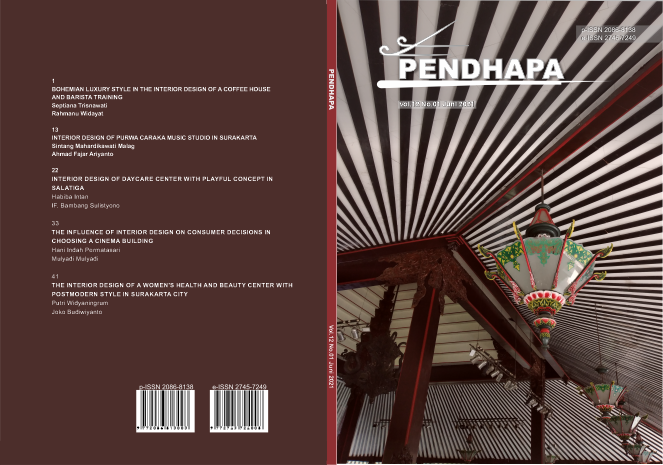Bohemian Luxury Style in the Interior Design of a Coffee House and Barista Training
DOI:
https://doi.org/10.33153/pendhapa.v12i1.3871Keywords:
Coffee House, Barista Training, Bohemian Luxury, Design InteriorAbstract
This Bohemian Luxury Coffee House Interior Design and Barista Training aims to (1) produce a coffee house interior design that is able to fulfil commercial, educational, and entertainment functions. (2) Providing interior design for a coffee house with a bohemian luxury style. The method used in this research is programming, including literature study, survey, and interview. Then data analysis, development of ideas, and design methods. From this analysis, it can be concluded several things (1) The interior design of the Coffee House and Barista Training as a solution for coffee lovers to gather and share knowledge about the types of coffee or the correct coffee making (2) Shapes, colours and materials applied according to with the theme of bohemian luxury in all interior elements. (3) The atmosphere of the space that is raised is a relaxed, comfortable, and elegant atmosphere.Downloads
References
Abele, A. E., Ellemers, N., Fiske, S. T., Koch, A., & Yzerbyt, V. (2021). Navigating the social world: Toward an integrated framework for evaluating self, individuals, and groups. Psychological Review, 128(2), 290–314. https://doi.org/10.1037/rev0000262
Basri, M. C. (2012). Rumah Ekonomi Rumah Budaya. Gramedia Pustaka Utama.
Cho, J. Y., & Suh, J. (2020). Interior Design. In Encyclopedia of Creativity (pp. 685–694). Elsevier. https://doi.org/10.1016/B978-0-12-809324-5.23600-6
Christine Piotrowski. (2004). Interior Designer. John Wiley & Sons, Inc.
Hawari, F. (2013). Kajian Estetika Kursi Eksperimental. Dimensi Interior, 9(2), 89–96. https://doi.org/10.9744/interior.9.2.89-96
Herlyana, E. (2012). Fenomena Coffee Shop. Sebagai Gejala Gaya Hidup Baru Kaum Muda.
Mcdonagh, J., Bowring, J., & Perkins, H. (2018). The consumption of chaos: from the charm of chaos to the tedium of order – the case of Christchurch, New Zealand before and after the central city post-earthquake rebuild. 855–866. https://doi.org/10.2495/SDP180721
Motoki, K., Takahashi, A., & Spence, C. (2021). Tasting atmospherics: Taste associations with colour parameters of coffee shop interiors. Food Quality and Preference, 94, 104315. https://doi.org/10.1016/j.foodqual.2021.104315
Nugroho, A. (2014). The Impact of Food Safety Standard on Indonesia’s Coffee Exports. Procedia Environmental Sciences, 20, 425–433. https://doi.org/10.1016/j.proenv.2014.03.054
Olofsson, E., & Sjolen, K. (2006). Design Sketching.pdf (2nd ed.). KEEOS Design Book.
Rahardjo, P. (2012). Kopi. Penebar Swadaya Grup.
Shofwan, M., Soehardjoepri, S., Erma Widiana, M., Wahyudi, S., Hafid Syaifudin, W., & Enny Widyaningrum, M. (2021). Inovasi Pengrajin Racikan Biji Kopi “REMPAH” Healthy Herbal Dan Berdaya Saing Tinggi Berbasis Santripreneur. Jurnal Abadimas Adi Buana, 4(2), 110–118. https://doi.org/10.36456/abadimas.v4.i2.a2744
Song, H., Wang, J., & Han, H. (2019). Effect of image, satisfaction, trust, love, and respect on loyalty formation for name-brand coffee shops. International Journal of Hospitality Management, 79, 50–59. https://doi.org/10.1016/j.ijhm.2018.12.011
Souza Almeida, F., Furlan Goncalves Dias, F., Kawazoe Sato, A. C., & Leite Nobrega de Moura Bell, J. M. (2021). From solvent extraction to the concurrent extraction of lipids and proteins from green coffee: An eco-friendly approach to improve process feasibility. Food and Bioproducts Processing, 129, 144–156. https://doi.org/10.1016/j.fbp.2021.08.004
Sudiartini, N. W. A., Astari, A. A. E., Kardini, N. L., & Dhani, Y. R. (2020). The feasibility study of coffee house business opportunity in COVID-19 pandemic: a case study at kulo coffee shop pemogan. International Research Journal of Management, IT and Social Sciences, 7(5), 38–45.
Downloads
Published
Issue
Section
License
Authors who publish with Pendhapa agree to the following terms:
- Authors retain copyright and grant the journal right of first publication with the work simultaneously licensed under a Creative Commons Attribution License (CC BY-SA 4.0) that allows others to share the work with an acknowledgment of the work's authorship and initial publication in this journal.
- Authors are able to enter into separate, additional contractual arrangements for the non-exclusive distribution of the journal's published version of the work (e.g., post it to an institutional repository or publish it in a book), with an acknowledgment of its initial publication in this journal.
- Authors are permitted and encouraged to post their work online (e.g., in institutional repositories or on their website) prior to and during the submission process, as it can lead to productive exchanges, as well as earlier and greater citation of published work.

This work is licensed under a Creative Commons Attribution-ShareAlike 4.0 International License.









